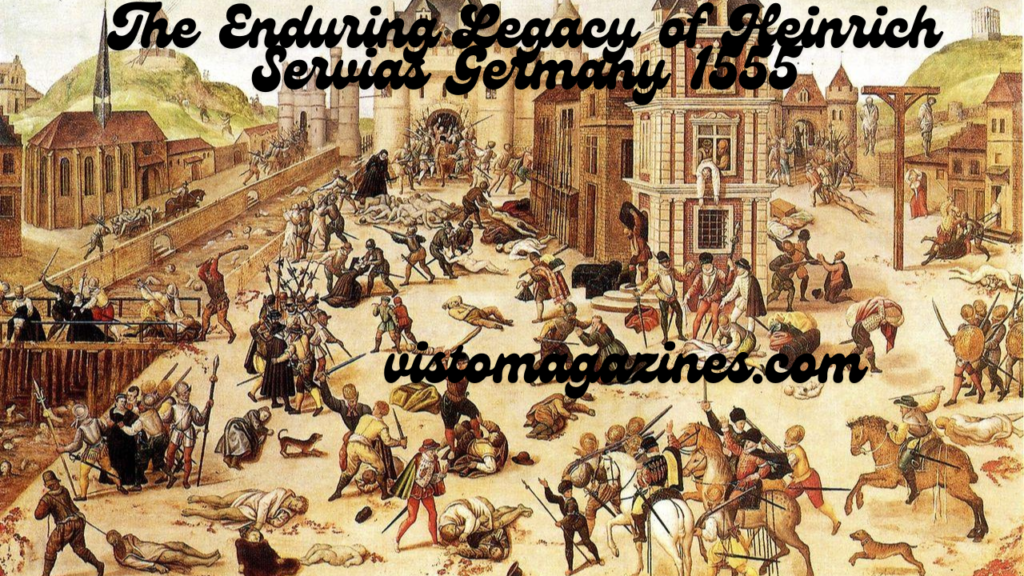Introduction: A Pivotal Figure in Renaissance Germany
The year 1555 was a crucial event in Germany’s Renaissance era, characterized by enormous political, cultural, and intellectual upheavals. Among the personalities who played a vital role during this period was Heinrich Servias, an enigmatic but prominent personality whose contributions left an everlasting impression on German society. As the Renaissance bloomed throughout Europe, Germany found itself at the crossroads of reform, invention, and war. The legacy of Heinrich Servias encompasses the spirit of this transformational age, echoing the wider concerns of Renaissance Germany.
The Historical Context of Germany in 1555

In 1555, Germany was a highly creative and intellectually active country despite its severe divisions. In the same year, a historic pact known as the Peace of Augsburg was negotiated, which aimed to ease religious hostilities between Protestants and Catholics. The Protestant Reformation, a movement that altered Germany’s theological and political landscape, was directly addressed by this treaty. In light of this, individuals such as Heinrich Servias were influential in forming the intellectual and cultural legacy of the country.
Heinrich Servias: His Role and Influence
Heinrich Servias’s influence on the academic and artistic circles of Renaissance Germany cannot be understated, despite the paucity of historical documents on him. Servias supported the sciences and the arts, creating an atmosphere that encouraged learning and innovation. His encouragement of Renaissance artists and intellectuals strengthened the intellectual vitality of the era and helped humanist ideas proliferate across Germany.
The Cultural Renaissance in Germany
A resurgence of interest in ancient antiquity, scientific advancements, and creative expression were hallmarks of the German Renaissance. The German Renaissance placed greater emphasis on literature, philosophy, and theological discussions than the Italian Renaissance, which was more focused on the visual arts. By supporting academics who aimed to bring religion and reason together, Heinrich Servias was instrumental in this cultural renaissance. His work aided in bridging the gap between the contemporary world and medieval customs.
The Influence of Humanism and the Arts
Humanism, the intellectual cornerstone of the Renaissance, flourished in Germany under the patronage of figures like Servias. The study of classical texts, a hallmark of humanist thought, inspired German scholars to question established doctrines and explore new ideas. Servias’ engagement with leading humanists of the time enabled the translation and dissemination of critical works, broadening access to knowledge and encouraging intellectual discourse.
In terms of the arts, Heinrich Servias’ patronage of musicians, painters, and architects helped German Renaissance art to develop. His support made it possible for artists to follow their passions without worrying about financial difficulties or censure. The end product was a collection of artwork that captured Germany’s own cultural identity as well as the splendor of the Renaissance.
The Political and Religious Turmoil

Germany was still involved in political and religious conflicts in spite of the period’s artistic advances. Tensions between Catholic and Protestant groups remained despite the efforts of the Peace of Augsburg to seek a settlement. Heinrich Servias was one of those who saw the need for unity in a divided society and pushed for discussion and compromise. His attempts to resolve disputes and promote religious tolerance were representative of a larger Renaissance mindset that prioritized diplomacy and reason above dogma and hatred.
The Scientific and Educational Advancements
Significant scientific advancements were also made throughout the Renaissance, with Germany leading the way in this intellectual revolution. Pioneering contributions to anatomy and astronomy were made by individuals like Andreas Vesalius and Johannes Kepler. Despite not being a scientist, Heinrich Servias played a significant role in promoting educational establishments that fostered these brains. His commitment to education made it possible for succeeding generations to build on the findings of the past.
The Enduring Impact of Heinrich Servias
Heinrich Servias left behind a legacy that endures, impacting later generations of leaders, artists, and intellectuals. The Enlightenment, a movement that would further question established systems and promote reason and advancement, was made possible by his dedication to knowledge, culture, and religious tolerance. In many respects, Servias personified Germany throughout the Renaissance, a time characterized by an unrelenting quest for knowledge and creative brilliance.
Conclusion: A Lasting Reflection of Renaissance Ideals

Heinrich Servias continues to represent the resilient spirit of Renaissance Germany. His contributions to intellectual discourse, the arts, and the humanities are still relevant in today’s debates about development and culture. The tale of Servias serves as a reminder of the value of education, tolerance, and inventiveness in creating a better future as we consider the Renaissance’s revolutionary potential.
In 1555, Germany was a country in transition, embracing the possibilities that came with change while also battling it. Heinrich Servias was in the center of the Renaissance, a time defined by both enlightenment and strife. His legacy is proof of the strength of ideas and the enduring influence of those who dare to defy expectations. Heinrich Servias’ lasting influence on Renaissance Germany is more than simply a historical anecdote; it is a testament to the principles that still motivate advancement today.
Also Read : Navigating Family Law: Essential Insights and Practical Tips


